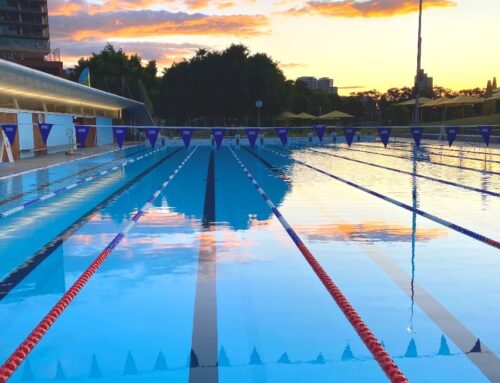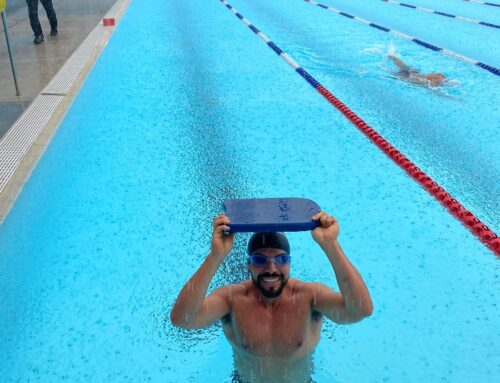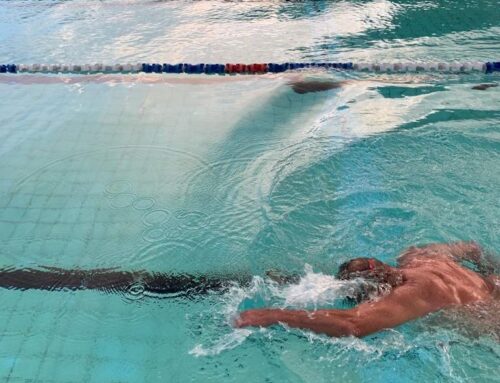Her eyes appeared to smart as she held back the tears. Her fear was palpable. The tenacity and determination she had mustered to get here. Rushing to get here in her busy life. She must learn, if for no other reason than the sake of her son. Yes, even she couldn’t believe she was here, wearing her neck-to-ankle suit to prevent any chance of a tan, donned cap and goggles. She was poolside ready to have her swimming lesson.
We’ll call her Joy. Like several of my clients, Joy has arrived to learn to swim wearing an invisible boulder around her neck. The boulder of fear. The fear of drowning. A fear that stems from an experience that happened to her recently or in childhood, possibly one that permeated the life of her entire family.
In my role as the owner of an adult swim school, I meet people who have been touched by a drowning or near-drowning incident. This fear acts as a double-edged sword, driving people to the pool to learn to swim, but paralysing them when they get there. It’s hard to learn to swim when you’re ridged with anxiety.
Drownings very sadly, made headlines in the media all too frequently this summer. Impacting all age groups. Children in pools, adults rescuing others in surf and open waters, swimmers in flooding rivers, all in all, too many. Traumatising all those involved. Shocking audiences and the broader Australian community. There has been an outcry. Every Australian child should be able to swim 50m by the time they leave school. Recent studies show this is not the case. The swimming ability of this nation’s children falls way short. What about the adults?
The number of adults wishing to learn to swim has increased in line with the number of new Australians and overseas students entering the country. But it’s not just new Australians. What about those of us who have grown up here and slipped through the cracks when it came to swimming lessons? Many adults from all backgrounds come to us with a deep-seated fear of the water.
Sometimes prospective swimmers are not even conscious of their heightened anxiety. It is submerged within and deeply personal. It creeps up on them as they start to move through the water, as they try to float and give in to the watery environment or the first time they’re taken out of their depth. It is this anxiety that can lead them into trouble without the support of a sensitive, well-trained instructor. It can see them give up.
Working through a progression of drills to develop the skills to learn to swim in a secure environment, assists in building confidence. In my experience this is the best way is to look into the eye of the tiger, to ‘face the fear and do it anyway’, holding the metaphoric hand of someone more experienced as you do. Becoming familiar with the water is fundamental. We say ‘touch the water’ as often as possible. Get into your nearest pool frequently and practise.
As I reflect on my own experience learning to swim freestyle as an adult, I realise my own family went through a drowning incident when I was very young. My younger brother, a baby at the time, crawled into the swimming pool of friends’ of my parents. I can vaguely remember pieces of the event, the panic, the shouting. An ambulance was called and he was very fortunately brought back to life. This situation was rarely spoken of in the family and I’m not sure he would spend any time thinking about it. I believe it adversely affected my parents. Very quietly they would individually refer to it from time to time. This no doubt led to my father’s overprotective nature near swimming pools and my mother’s concern for us bathing at the beach. My mother’s concern was further exasperated by her lack of confidence in the water, only swimming a small amount of breaststroke. She was born in Europe.
The need for sensitivity and gentleness is critical in a swim instructor helping a frightened participant. Small classes with instructors who are in the water during the lesson are essential. Deep water familiarisation needs to take place. With exposure to different water levels and the development of skills, so comes courage and then confidence.
My eighty two year old mother is about to start learn to swim classes. I’m excited for her and hope by teaching her to swim we’ll help her overcome her fear of the water. It just proves you’re never too old to learn. It’s never too late to release yourself and enjoy the freedom and pleasure that swimming offers. Most importantly you’ll become a water safe Australian adult!
Kari Baynes 24 April 2017






